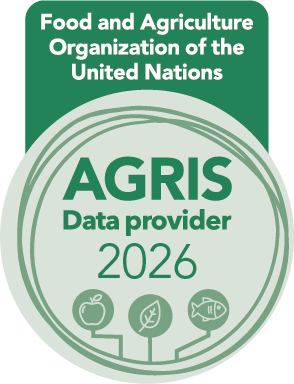Studies on genetic divergence for yield and quality traits in chilli (Capsicum annuum L.)
DOI:
https://doi.org/10.24154/jhs.v20i1.1968Keywords:
Chilli, Cluster Analysis, D2 Analysis, genetic divergenceAbstract
A study was conducted to assess the genetic divergence of twenty-five chilli genotypes for fifteen parameters by adopting Mahalanobis D2 statistics using Tocher’s method. The genotypes were grouped into six clusters irrespective of their geographical divergence, indicating wide diversity among them. Cluster II was the largest with nine genotypes followed by Cluster I with eight genotypes, cluster III with four genotypes, cluster IV with two genotypes, and Clusters V and VI had only one genotype each. The maximum inter-cluster distance was observed between clusters V and VI followed by clusters IV and V and clusters III and IV. This indicates that hybridization between the genotypes belonging to clusters V and VI will be more rewarding for getting superior progenies in terms of yield and quality.
Downloads
References
Allard, R. W. (1960). *Principles of plant breeding*. John Wiley & Sons.
Janaki, M., Naidu, L. N., Ramana, C. V., & Rao, M. P. (2016). Genetic divergence among chilli (*Capsicum annuum* L.) genotypes based on quantitative and qualitative traits. *International Journal of Science and Nature, 7*(1), 181-189.
Joshi, A. K., Korla, B. N., Kohli, U. K., & Goyal, R. K. (2000). *Vegetable breeding: A practical guide* (pp. 173-230). Centre of Advanced Studies in Horticulture (Vegetables), Department of Vegetable Crops, UHF Nauni.
National Horticulture Board. (2020). *Database of horticultural crops*. Gurgaon, New Delhi. [http://www.nhb.gov.in](http://www.nhb.gov.in)
Pujar, U. U., Tirakannanavar, S., Jagadeesha, R. C., Gasti, V. D., & Sandhyarani, N. (2017). Genetic variability, heritability, correlation and path analysis in chilli (*Capsicum annuum* L.). *International Journal of Pure and Applied Bioscience, 5*(5), 579-586. [https://doi.org/10.18782/2320-7051.5814](https://doi.org/10.18782/2320-7051.5814) *(if DOI exists, include)*
https://doi.org/10.18782/2320-7051.5878
Rao, C. R. (1952). *Advanced statistical methods in biometrical research* (pp. 357-363). John Wiley & Sons.
Singh, S., Joshi, A. K., Vikram, A., Kansal, S., & Singh, S. (2023). Divergence studies in chilli genotypes (*Capsicum annuum* L.). *International Journal of Economic Plants, 10*(1), 27-30.
https://doi.org/10.23910/2/2023.0512
Singh, S. N., Shrivastava, J. P., & Ram. (1994). Natural outcrossing in chilli. *Vegetable Science, 21*, 166-168.
Vanitha, & Jansirani. (2017). Studies on genetic divergence in chilli. *International Journal of Agricultural Science and Research, 7*(1), 15-20.
Verma, G., Vikram, A., & Gupta, M. (2022). Diversity and genetic association analysis of dry chillies (*Capsicum annuum* L.) of Northern India for yield and biochemical traits. *International Journal of Bio-resource and Stress Management, 13*(12), 1391-1397. [https://doi.org/10.23910/1.2022.2504](https://doi.org/10.23910/1.2022.2504) *(if DOI exists, include)*
https://doi.org/10.23910/1.2022.3285
Yatung, T., Dubey, R. K., Singh, V., & Upadhyay. (2014). Genetic diversity of chilli (*Capsicum annuum* L.) genotypes of India based on morpho-chemical traits. *Australian Journal of Crop Science, 8*(1), 97-102.
Downloads
Published
Issue
Section
License
Copyright (c) 2025 Sai Timma Rao Koka, H Sharma, R K Dogra (Author)

This work is licensed under a Creative Commons Attribution-NonCommercial-ShareAlike 4.0 International License.
Authors retain copyright. Articles published are made available as open access articles, distributed under the terms of the Creative Commons Attribution-NonCommercial-ShareAlike 4.0 International License, which permits unrestricted non-commercial use, distribution, and reproduction in any medium, provided the original author and source are credited. 
This journal permits and encourages authors to share their submitted versions (preprints), accepted versions (postprints) and/or published versions (publisher versions) freely under the CC BY-NC-SA 4.0 license while providing bibliographic details that credit, if applicable.







 .
. 











